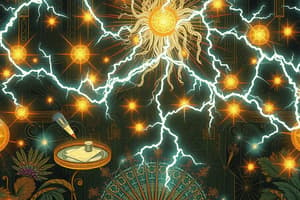Podcast
Questions and Answers
What subatomic particles carry electric charges?
What subatomic particles carry electric charges?
- Bosons and fermions
- Muons and tauons
- Neutrons and quarks
- Protons and electrons (correct)
What happens when electric charges interact with each other?
What happens when electric charges interact with each other?
- They always repel each other
- They repel or attract each other (correct)
- They remain unaffected
- They always attract each other
What is a point charge?
What is a point charge?
- A charge with a finite size
- A charge concentrated at a single point in space (correct)
- A charge distributed over a large area
- A charge that is constantly moving
What is a test charge?
What is a test charge?
Who discovered the inverse square law for electric forces?
Who discovered the inverse square law for electric forces?
What did Coulomb use to study the attractive and repulsive forces between charges?
What did Coulomb use to study the attractive and repulsive forces between charges?
What is the fundamental force that governs the attraction and repulsion between electric charges?
What is the fundamental force that governs the attraction and repulsion between electric charges?
Which statement accurately describes the direction of electric field lines?
Which statement accurately describes the direction of electric field lines?
In the sample problem where two charges, $q_1 = +8\mu C$ and $q_2 = -5\mu C$, are separated by $r = 10$ cm, what is the nature of the electrostatic force between them?
In the sample problem where two charges, $q_1 = +8\mu C$ and $q_2 = -5\mu C$, are separated by $r = 10$ cm, what is the nature of the electrostatic force between them?
If two equal charges of magnitude $1.1\times 10^{-7}$ C experience an electrostatic force of $4.2\times 10^{-4}$ N, what is the approximate distance between their centers?
If two equal charges of magnitude $1.1\times 10^{-7}$ C experience an electrostatic force of $4.2\times 10^{-4}$ N, what is the approximate distance between their centers?
If three charged particles are arranged in a line, with charges $q_A = -5\mu C$, $q_B = +10\mu C$, and $q_C = -12\mu C$, what is the net electrostatic force on $q_B$ due to the other two charges?
If three charged particles are arranged in a line, with charges $q_A = -5\mu C$, $q_B = +10\mu C$, and $q_C = -12\mu C$, what is the net electrostatic force on $q_B$ due to the other two charges?
If a charge of $-70\mu C$ is observed, approximately how many electrons represent this charge?
If a charge of $-70\mu C$ is observed, approximately how many electrons represent this charge?
Flashcards are hidden until you start studying




